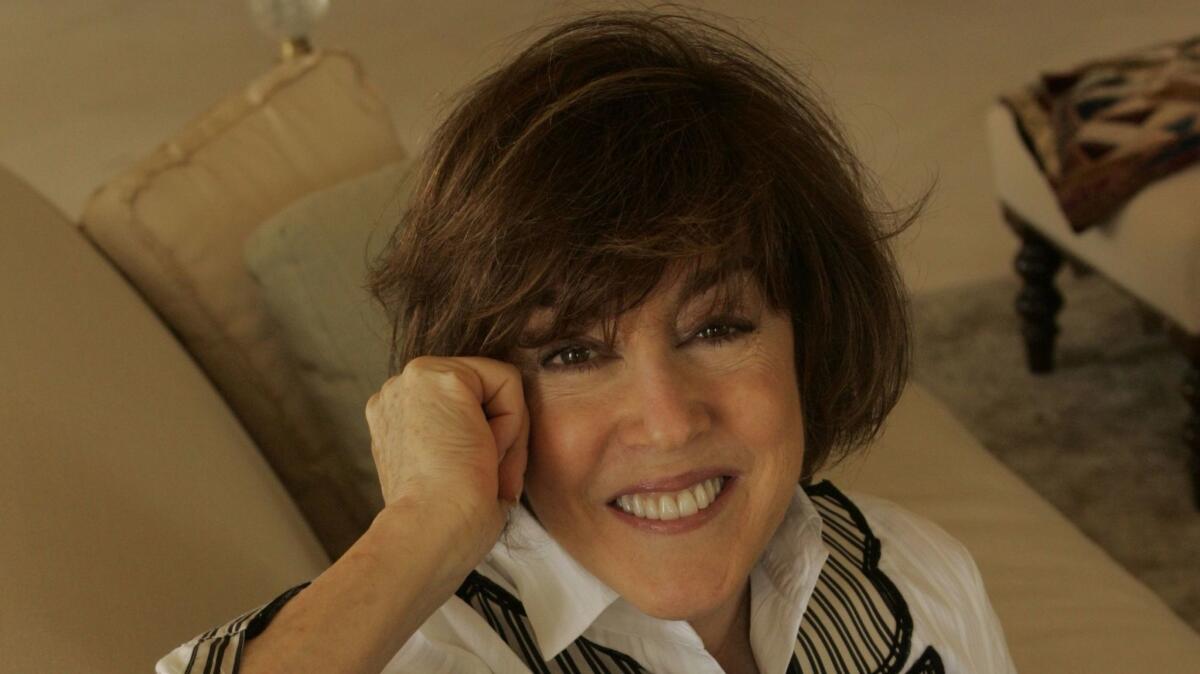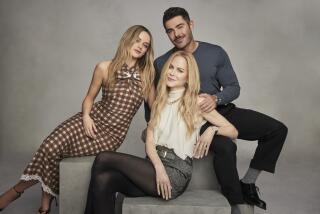Review: The new book ‘I’ll Have What She’s Having’ looks at what made Nora Ephron’s three best films great
Romantic comedies aren’t for everybody. It takes a certain kind of person to watch “Pretty Woman” whenever they come across it on TV, argue that “Boomerang” is an overlooked classic, and make fun of Adam Sandler films but defend “The Wedding Singer” to the death. Today, thanks to films like “The Big Sick” and television shows like “The Mindy Project,” the rom-com is having a moment. But the case Erin Carlson makes in “I’ll Have What She’s Having” is solid: Nora Ephron reinvented and saved the genre with “When Harry Met Sally,” “Sleepless in Seattle” and “You’ve Got Mail.”
There’s no study that concludes the hows and whys people gravitate toward these kinds of films and shows. Personally speaking, I think it’s all about conditioning — grandparents who watched “The Philadelphia Story” and “It Happened One Night” while they babysat me made me fall in love with movies about falling in love. The television was on and, as a child of divorced parents, watching people end up together after a series of hilarious events and wrong turns must have spoken to me, stuck just far enough in the suburbs, the Chicago city skyline visible on sunny days.
There’s also something downright stylish about rom-coms. From films starring icons Cary Grant and Katharine Hepburn to Molly Ringwald’s character pining over Jake Ryan (one of the all-time great movie hunks) in “Sixteen Candles,” these movies and the people in them look good.

That’s maybe the first thing I noticed about the Ephron-penned “When Harry Met Sally,” the urbanites and their interesting lives: Billy Crystal with his great sweaters, Meg Ryan faking an orgasm at Katz’s. I lucked out and first saw the Rob Reiner-directed 1989 film at an early enough age that it stuck. This is what life and loving in the big city is like and everything turns out great in the end? Sign me up!
Leading up to “When Harry Met Sally,” the state of the rom-com was in a strange place, filled with movies about lovesick suburban teens (the bulk of John Hughes’ work from the decade, Cameron Crowe’s “Say Anything…”), the fairy tale “The Princess Bride,” and male-dominated dramas. Many films were written and directed by men and based on the premise of whether the guy would get the girl. You had some wonderful outliers (“Moonstruck” and “Working Girl” are both classics that come to mind), but things were becoming too formulaic.

“Too many romantic comedies contained warring duos, low stakes, and predictable endings,” Carlson writes. Ephron reinvigorated the genre, Carlson writes in “I’ll Have What She’s Having,” which focuses on those three films she’s best known for: Harry meeting Sally and the two Meg Ryan and Tom Hanks vehicles, “Sleepless in Seattle” and “You’ve Got Mail.”
Although Ephron also worked on a few other great, sometimes underrated films (the book gives adequate page space to the great 1992 adaptation of a Meg Wolitzer novel by Ephron and her sister Delia, “This Is My Life”), and of course had a successful career as a writer and journalist, these serve as the buildup to her film trio. Carlson tells Ephron’s story to give the reader context as to the hows and whys Ephron was the right person for the job.
There are no huge surprises. Carlson relies mostly on research and quotes from people who worked on the films. This isn’t a biography, but Carlson does mix that style of storytelling together with criticism and insight into the state of the movies in the years each of the three films came out. They went up against muscle-bound action hero Arnold Schwarzenegger and “Jurassic Park” for box office revenue, but Ephron and her movies had something that viewers were longing for.

“I’ll Have What She’s Having,” in part, gives us a glimpse into the making of the films. “A stickler for specifics,” Carlson writes, Ephron fired a prop guy while filming a movie in Toronto that was supposed to be set in New York City for using generic cream soda instead of the very New York City brand Dr. Brown’s). Carlson writes of Ephron’s famous love of food, and the actors who were considered for, but not cast in, some of the most iconic roles (Debra Winger, Helen Hunt and Meg Tilly were all considered for Sally, while Kirstie Alley and Marisa Tomei were in the running for Becky, the best friend in “Sleepless in Seattle” played by Rosie O’Donnell).
But ultimately, the book serves to show how the movies were made and the effect they had. The films’ influence is definitely a huge part of it, but also what effect it had on the stars, most notably Ryan. “When Harry Met Sally” costar Harley Jane Kozak tells Carlson, “America will never forgive Meg Ryan for growing old,” and that her work with Ephron was “the perfect storm of genre, decade, style, and her particular form of youthfulness.” Carlson writes that Ryan went from “America’s Sweetheart to Hester Prynne overnight” for a tabloid affair with Russell Crowe.
Ryan, just like Ephron, would go on to make a few notable films after 1998’s “Sleepless in Seattle,” but she’d never achieve the same level of success. “Julie & Julia,” Ephron’s best post-rom-com era work, would come out three years before her death. A lighthearted, funny movie about love, this one involving two different women (one, Julia Child) with the romantic partner being cooking, it was a welcome reminder of what made Ephron and her films so special. Her combination of sophistication, style, humor and cleverness. That warm blanket feeling that nothing really too traumatic is going to take place when you sit down to watch, that there’s a good chance everything will turn out like you want it to in the end. We like rom-coms because love and laughter never go out of style, and Ephron understood perfectly how to make those two things work together.
Diamond writes about culture and is the author of the memoir “Searching for John Hughes.”
“I’ll Have What She’s Having: How Nora Ephron’s Three Iconic Films Saved the Romantic Comedy”
Erin Carlson
Hachette Books: 352 pp., $28
More to Read
Sign up for our Book Club newsletter
Get the latest news, events and more from the Los Angeles Times Book Club, and help us get L.A. reading and talking.
You may occasionally receive promotional content from the Los Angeles Times.







